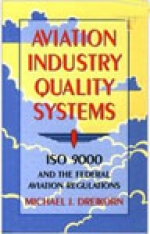Tab Article
This single-source reference is the first book of its kind that provides proven implementation models and tools needed to develop a quality assurance system in the commercial aviation industry. Author show aviation professionals how to develop a quality system that complies with both the ANSI/ISO/ASQC Q9000 series quality standards and the applicable regulations of the Federal Aviation Administration(FAA). The models displayed can be implemented in organizations that are approved or are seeking approval as manufacturers under FAR Part 21, including designated alteration station and repair station approvals (FAR Part 145). The evaluation criteria of the FAA's Aircraft Certification System Evaluation Program (ACSEP) is also discussed.
The 21 chapters and more than 50 illustrations in this book support the development of a quality assurance system and addresses the issues of certification and registration in the commercial aviation industry. Dreikorn organizes the chapters according to the major requirements of the ANSI/ISO/ASQC Q9001-1994 quality standard and presents models of conformance to the federal aviation regulations (FARs). Chapter topics include.
Quality sytems
Contract review
Design control
Document and data control
Product identification and traceability
Control of inspection, measuring, and test equipment
Corrective and preventive action
And more
Specific examples and sample forms show users how to meet the requirements of ISO and FARs. Appendix A contains helpful cross-reference matrices that actually compare sections of each set of quality standard requirements, including ACSEP. Also included is material that shows how mil-spec contractors can implement the requirements of production certificate approval and those of ANSI/ISO/ASQC Q9001-1994 to help meet the generic requirements of the Department of Defense and the National Aeronautics and Space Administration. Foreign aircraft manufacturers and suppliers will find this to be a valuable reference guide in helping them meet and better understand U.S. aviation requirements.
The book features a glossary that defines acronyms used in the aviation industry. Each chapter stands alone and concludes with a chapter summary, which makes this book useful as a training and teaching text


